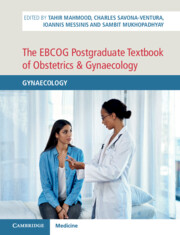Book contents
- The EBCOG Postgraduate Textbook of Obstetrics & Gynaecology
- The EBCOG Postgraduate Textbook of Obstetrics & Gynaecology
- Copyright page
- Dedication
- Contents
- Videos
- Contributors
- Preface
- Section 1 Basic Sciences in Gynaecology
- Section 2 Menstrual Disorders
- Section 3 Reproductive Endocrinology and Infertility
- Section 4 Contraception and STIs
- Section 5 Post-Reproductive Care
- Section 6 Vulva and Vagina
- Section 7 Cervix
- Section 8 Uterus
- Section 9 Ovary and Fallopian Tubes
- Section 10 Operative Gynaecology
- Chapter 43 Basic Hysteroscopy
- Chapter 44 Advanced Hysteroscopy
- Chapter 45 Basic Laparoscopic Gynaecological Procedures
- Chapter 46 Advanced Laparoscopic Gynaecological Procedures
- Chapter 47 Robotic Gynaecological Surgery
- Chapter 48 Myomectomy
- Chapter 49 Hysterectomy for Benign Conditions
- Chapter 50 Reversal of Sterilization in Females and Males to Restore Fertility
- Section 11 Public Health Issues in Gynaecology
- Section 12 Miscellaneous
- Index
- Plate Section (PDF Only)
- References
Chapter 49 - Hysterectomy for Benign Conditions
from Section 10 - Operative Gynaecology
Published online by Cambridge University Press: 24 November 2021
- The EBCOG Postgraduate Textbook of Obstetrics & Gynaecology
- The EBCOG Postgraduate Textbook of Obstetrics & Gynaecology
- Copyright page
- Dedication
- Contents
- Videos
- Contributors
- Preface
- Section 1 Basic Sciences in Gynaecology
- Section 2 Menstrual Disorders
- Section 3 Reproductive Endocrinology and Infertility
- Section 4 Contraception and STIs
- Section 5 Post-Reproductive Care
- Section 6 Vulva and Vagina
- Section 7 Cervix
- Section 8 Uterus
- Section 9 Ovary and Fallopian Tubes
- Section 10 Operative Gynaecology
- Chapter 43 Basic Hysteroscopy
- Chapter 44 Advanced Hysteroscopy
- Chapter 45 Basic Laparoscopic Gynaecological Procedures
- Chapter 46 Advanced Laparoscopic Gynaecological Procedures
- Chapter 47 Robotic Gynaecological Surgery
- Chapter 48 Myomectomy
- Chapter 49 Hysterectomy for Benign Conditions
- Chapter 50 Reversal of Sterilization in Females and Males to Restore Fertility
- Section 11 Public Health Issues in Gynaecology
- Section 12 Miscellaneous
- Index
- Plate Section (PDF Only)
- References
Summary
Despite the efforts for conservative treatment for several benign entities, hysterectomy is the therapeutic cornerstone. The current chapter presents an overview of the surgical techniques, as these are applied via different surgical approaches: abdominal, vaginal and minimal access. Special emphasis is given to the potential complications encountered during the postoperative period. Several issues of controversy are also discussed and suggestions have been made according to the current guidelines. It is evident that hysterectomy should always be included in a training curriculum with the surgical skill being maintained via a minimum number of procedures performed yearly. Route selection is very important in reducing possible complications. In the same direction, whenever possible, an enhanced patient recovery scheme should be applied.
- Type
- Chapter
- Information
- The EBCOG Postgraduate Textbook of Obstetrics & GynaecologyGynaecology, pp. 432 - 436Publisher: Cambridge University PressPrint publication year: 2021

